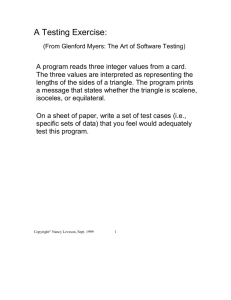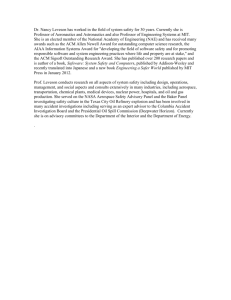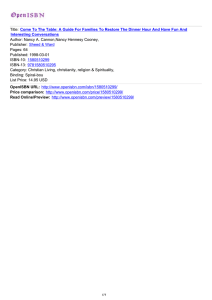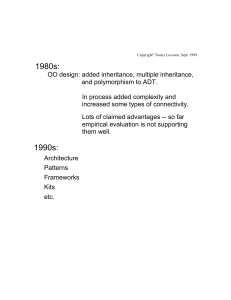Traditional Safety Analysis Quantitative Methods 1
advertisement
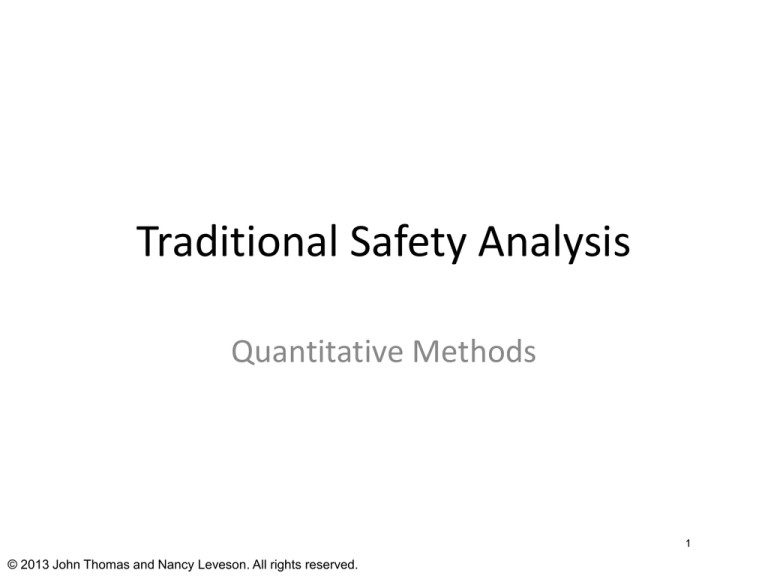
Traditional Safety Analysis Quantitative Methods 1 © 2013 John Thomas and Nancy Leveson. All rights reserved. Agenda • Last time: Qualitative methods – FMEA – FTA – Limitations • Today – More Qualitative methods • ETA • HAZOP – Quantitative methods • • • • FMECA FTA ETA PRA – Limitations 2 © 2013 John Thomas and Nancy Leveson. All rights reserved. Event Tree Analysis 3 © 2013 John Thomas and Nancy Leveson. All rights reserved. Event Tree Analysis • 1967: Nuclear power stations • Forward search technique – Initiating event: component failure (e.g. pipe rupture) – Goal: Identify all possible outcomes 4 © 2013 John Thomas and Nancy Leveson. All rights reserved. Event Tree Analysis: Process 2 1. Identify initiating event 2. Identify barriers 3. Create tree 4. Identify outcomes 3 4 1 5 © 2013 John Thomas and Nancy Leveson. All rights reserved. Courtesy of USENIX. Used with permission. Event Tree Example No accident Small release No release Moderate release No release Major release 6 © 2013 John Thomas and Nancy Leveson. All rights reserved. Event Trees vs. Fault Trees Event Tree - Shows what failed, but not how. - Shows order of events Fault Tree - Complex, but shows how failure occurred - Does not show order of events 7 © 2013 John Thomas and Nancy Leveson. All rights reserved. ETA uses an accident model Event Tree: Accident model: Chain-of-events Pressure too high Relief valve 1 fails Relief valve 2 fails Explosion 8 © 2013 John Thomas and Nancy Leveson. All rights reserved. Event Tree Analysis: Exercise Elevator 1. Identify initiating event – Cable breaks 2. List Barriers 3. Create Tree 4. Identify outcomes 9 © 2013 John Thomas and Nancy Leveson. All rights reserved. Image : Public Domain. USMSHA. Event Tree Analysis: Exercise Images removed due to copyright restrictions. See: http://science.howstuff works.com/science-vs-myth/everyday-myths/question730.htm What are the barriers? 10 © 2013 John Thomas and Nancy Leveson. All rights eserved. Event Tree Analysis: Strengths • Handles ordering of events better than fault trees • Most practical when events can be ordered in time (chronology of events is stable) • Most practical when events are independent of each other. • Designed for use with protection systems (barriers) 11 © 2013 John Thomas and Nancy Leveson. All rights reserved. Event Tree Analysis: Limitations • Not practical when chronology of events is not stable (e.g. when order of columns may change) • Difficult to analyze non-protection systems • Can become exceedingly complex and require simplification • Separate trees required for each initiating event – Difficult to represent interactions among events – Difficult to consider effects of multiple initiating events 12 © 2013 John Thomas and Nancy Leveson. All rights reserved. Event Tree Analysis: Limitations (cont) • Can be difficult to define functions across top of event tree and their order • Requires ability to define set of initiating events that will produce all important accident sequences • Most applicable to systems where: – All risk is associated with one hazard • (e.g. overheating of fuel) – Designs are fairly standard, very little change over time – Large reliance on protection and shutdown systems 13 © 2013 John Thomas and Nancy Leveson. All rights reserved. HAZOP Hazard and Operability Analysis 14 © 2013 John Thomas and Nancy Leveson. All rights reserved. HAZOP: Hazards and Operability Analysis • Developed by Imperial Chemical Industries in early 1960s • Not only for safety, but efficient operations Accident model: • Accidents caused by chain of failure events (finally!) • Accidents caused by deviations from design/operating intentions 15 © 2013 John Thomas and Nancy Leveson. All rights reserved. HAZOP • Guidewords applied to variables of interest – E.g. flow, temperature, pressure, tank levels, etc. • Team considers potential causes and effects • Questions generated from guidewords – – – – Could there be no flow? If so, how? How will operators know there is no flow? Are consequences hazardous or cause inefficiency? HAZOP: Generate the right questions, not just fill in a tree © 2013 John Thomas and Nancy Leveson. All rights reserved. 16 HAZOP Process Guidewords Meaning NO, NOT, NONE The intended result is not achieved, but nothing else happens (such as no forward flow when there should be) MORE More of any relevant property than there should be (such as higher pressure, higher temperature, higher flow, or higher viscosity) LESS Less of a relevant physical property than there should be AS WELL AS An activity occurs in addition to what was intended, or more components are present in the system than there should be (such as extra vapors or solids or impurities, including air, water, acids, corrosive products) PART OF Only some of the design intentions are achieved (such as only one of two components in a mixture) REVERSE The logical opposite of what was intended occurs (such as backflow instead of forward flow) OTHER THAN No part of the intended result is achieved, and something completely different happens (such as the flow of the wrong material) Figure removed due to copyright restrictions. See: Leveson, Nancy. 6DIHZDUH 6\VWHP6DIHW\DQG&RPSXWHUV. Addison-Wesley Professional, 1995. pp. 337. 17 © 2013 John Thomas and Nancy Leveson. All rights reserved. HAZOP Strengths • Considers more than failure accidents • Can identify new hazards – Not limited to previously identified hazards • Easy to apply – A simple method that can uncover complex accidents • Applicable to new designs and new design features • Performed by diverse study team, facilitator – Method defines team composition, roles – Encourages cross-fertilization of different disciplines 18 © 2013 John Thomas and Nancy Leveson. All rights reserved. HAZOP Limitations • Requires detailed plant information – Flowsheets, piping and instrumentation diagrams, plant layout, etc. – Tends to result in protective devices rather than real design changes • Developed/intended for chemical industry • Labor-intensive – Significant time and effort due to search pattern • Relies very heavily on judgment of engineers • May leave out hazards caused by stable factors • Unusual to consider deviations for systemic factors – E.g. organizational, managerial factors, management systems, etc. • Difficult to apply to software • Human behavior reduces to compliance/deviation from procedures – Ignores why it made sense to do the wrong thing © 2013 John Thomas and Nancy Leveson. All rights reserved. 19 Quantitative Methods 20 © 2013 John Thomas and Nancy Leveson. All rights reserved. Quantitative methods • How do you include numbers and math? – What do you quantify? • Tends to focus on two parameters – Severity – Probability • Seems intuitive to multiply: Risk = Severity * Likelihood 21 © 2013 John Thomas and Nancy Leveson. All rights reserved. Quantitative methods • The math is usually based on probability theory and statistics • Common assumptions – Behavior is random – Each behavior independent Good assumptions? 22 © 2013 John Thomas and Nancy Leveson. All rights reserved. Quantitative methods • The math is usually based on probability theory and statistics • Common assumptions – Behavior is random – Each behavior independent Good assumptions? -Software? -Humans? -Hardware? © 2013 John Thomas and Nancy Leveson. All rights reserved. 23 Risk Matrix • Based on common idea: Likelihood Risk = Severity * Likelihood Very Likely Likely Possible Unlikely Rare Negligible Minor Moderate Significant Severity © 2013 John Thomas and Nancy Leveson. All rights reserved. Severe 24 Risk Matrix • Based on common idea: Likelihood Risk = Severity * Likelihood Very Likely Uses expected values (averages) Low Med Medium Med Hi High High Likely Low Low Med Medium Med Hi High Possible Low Low Med Medium Med Hi Med Hi Unlikely Low Low Med Low Med Medium Med Hi Rare Low Low Low Med Medium Medium Negligible Minor Moderate Significant Severity © 2013 John Thomas and Nancy Leveson. All rights reserved. Severe 25 Expected Value Fallacy aka P-value Fallacy aka Flaw of Averages aka Jensen’s Law • Beware when averages are used to simplify the problem! – Can make adverse decisions appear correct 26 © 2013 John Thomas and Nancy Leveson. All rights reserved. Expected Value Fallacy Safety factor Probability of occurrence Probability of occurrence Expected failure strength Stress Expected Expected load Margin strength of safety (A) Probability density function of failure for two parts with same expected failure strength. Stress (B) A relatively safe case. Safety factor Probability of occurrence Expected load Expected strength Stress (C) A dangerous overlap but the safety factor is the same as in (b). Image by MIT OpenCourseWare. Remember this? 27 © 2013 John Thomas and Nancy Leveson. All rights reserved. Ordinal Values • Severity is usually ordinal – Only guarantees ordering along increasing severity – Distance between levels not comparable Interval Ordinal 4 • …and fixed 0 • Assumes severity 4 is 2x worse than severity 2 – A “Med Hi” result may actually be worse than “High” 6 4 5 • Ordinal multiplication can result in reversals – Multiplication assumes equal distance Ratio 3 4 3 2 1 2 3 1 2 0 1 Another problem 28 © 2013 John Thomas and Nancy Leveson. All rights reserved. Another Example Hazard Level Matrix 29 © 2013 John Thomas and Nancy Leveson. All rights reserved. Hazard Level Assessment • Not feasible for complex, human/computer controlled systems • No way to determine likelihood for these systems – Software behaves exactly the same way every time Hazard Level or Risk Level: High Med Hi • Not random – Humans adapt, and can change behavior over time • Adaptation is not random • Different humans behave differently – Modern systems almost always involve new designs and new technology • Historical data may be irrelevant • Severity is usually adequate to determine effort to spend on eliminating or mitigating hazard. © 2013 John Thomas and Nancy Leveson. All rights reserved. Medium Low Med Low 30 FMECA Failure Modes Effects and Criticality Analysis 31 © 2013 John Thomas and Nancy Leveson. All rights reserved. FMECA • Same as FMEA, but with “criticality” information • Criticality – Can be ordinal severity values – Can be likelihood probabilities – An expression of concern over the effects of failure in the system* *Vincoli, 2006, Basic Guide to System Safety © 2013 John Thomas and Nancy Leveson. All rights reserved. 32 FMEA worksheet Bridge crane system © Wiley. All rights reserved. This content is excluded from our Creative Commons license. For more information, see http://ocw.mit.edu/fairuse Failure Mode and Effect Analysis Program:_________ Engineer:_________ System:_________ Date:___________ Facility:________ Sheet:_________ Component Name Failure Modes Failure Mechanisms Failure effects (local) Failure effects (system) Criticality Level Main hoist motor Inoperative, does not move Defective bearings Main hoist cannot be raised. Brake will hold hoist stationary Load held stationary, cannot be raised or lowered. (5) High, customers dissatisfied Loss of power Broken springs © 2013 John Thomas and Nancy Leveson.2006) All rights reserved. *FMEA example adapted from (Vincoli, Severity Level Examples Rating Meaning 1 No effect 2 Very minor (only noticed by discriminating customers) 3 Minor (affects very little of the system, noticed by average customer) 4 Moderate (most customers are annoyed) 5 High (causes a loss of primary function; customers are dissatisfied) 6 Very high and hazardous (product becomes inoperative; customers angered; the failure may result unsafe operation and possible injury) 34 *Otto et al., 2001, Design © 2013 John Thomas andProduct Nancy Leveson. All rights reserved. Severity Level Examples Rating Severity of Effect 10 Safety issue and/or non-compliance with government regulation without warning. 9 Safety issue and/or non-compliance with government regulation with warning. 8 Loss of primary function. 7 Reduction of primary function. 6 Loss of comfort/convenience function. 5 Reduction of comfort/convenience function. 4 Returnable appearance and/or noise issue noticed by most customers. 3 Non-returnable appearance and/or noise issue noticed by customers. 2 Non-returnable appearance and/or noise issue rarely noticed by customers. 1 No discernable effect. *http://www.harpcosystems.com/Design-FMEA-Ratings-PartI.htm © 2013 John Thomas and Nancy Leveson. All rights reserved. 35 FMEA worksheet Bridge crane system Could also specify likelihood © Wiley. All rights reserved. This content is excluded from our Creative Commons license. For more information, see http://ocw.mit.edu/fairuse Failure Mode and Effect Analysis Program:_________ Engineer:_________ System:_________ Date:___________ Facility:________ Sheet:_________ Component Name Failure Modes Failure Mechanisms Failure effects (local) Failure effects (system) Probability of occurrence Main hoist motor Inoperative, does not move Defective bearings Main hoist cannot be raised. Brake will hold hoist stationary Load held stationary, cannot be raised or lowered. 0.001 per operational hour Loss of power Broken springs *FMEA example adapted from (Vincoli, 2006) © 2013 John Thomas and Nancy Leveson. All rights reserved. 36 Quantitative FTA 37 © 2013 John Thomas and Nancy Leveson. All rights reserved. Quantitative Fault Tree Analysis • If we can assign probabilities to lowest boxes… – Can propagate up using probability theory – Can get overall total probability of hazard! • AND gate – P(A and B) = P(A) * P(B) • OR gate – P(A or B) = P(A) + P(B) Any assumptions being made? 38 © 2013 John Thomas and Nancy Leveson. All rights reserved. Quantitative Fault Tree Analysis • If we can assign probabilities to lowest boxes… – Can propagate up using probability theory – Can get overall total probability of hazard! • AND gate – P(A and B) = P(A) * P(B) • OR gate – P(A or B) = P(A) + P(B) Only if events A,B are independent! Only if events A,B are independent! • Is independence a good assumption? – Hardware? – Software? – Humans? 39 © 2013 John Thomas and Nancy Leveson. All rights reserved. Quantitative Fault Tree Analysis Fault trees removed due to copyright restrictions. See RTCA DO-312 Safety, Performance and Interoperability Requirements Document for the In-Trail Procedure in the Oceanic Airspace (ATSA-ITP) Application http://www.rtca.org/store_product.asp?prodid=1095. Actual fault trees from RTCA DO-312 40 Quantitative Fault Tree Analysis • Where do the probabilities come from? – Historical data – Simulations – Expert judgment Are there any issues using these sources? Qualitative Frequency and Relation to Quantitative Probability for Basic Causes Qualitative Frequency Qualitative Probability Very Often 1E-01 to 1E-02 Often 1E-02 to 1E-03 Rare 1E-03 to 1E-04 Very Rare Less than 1E-04 Image by MIT OpenCourseWare. Based on qualitative-quantitative conversion from RTCA DO-312. © 2013 John Thomas and Nancy Leveson. All rights reserved. 41 Quantitative ETA 42 © 2013 John Thomas and Nancy Leveson. All rights reserved. Quantitative Event Tree Analysis Quantitative Event Tree Analysis OH Barrier 1a Barrier 1b Barrier 1c Barrier 1d Barrier 2 Barrier 3 0.993116 A 0.987384 B OH 2U-7 6.88E-03 X 0.992699 C 1.26E-02 Y OE Sev. Effects Pe 5 No safety effect 4 Loss of separation 5 < x < 10 NM 6.80E-03 X&B 3 Significant reduction in separation 1 < x < 5 NM 8.62E-05 X&C&C Large reduction in safety margins x < 1 NM 6.21E-07 X&Y&Z& (D or E or F) 0.93577236 D 0.90 E 0.80 F 2 5.36E-02 V 0.10 W 0.20 S 1 7.30E-03 Z 6.80E-10 Near mid-air collision/collision X&Y&Z& V&W&S Image by MIT OpenCourseWare. Based on event tree from RTCA DO-312. • Quantify p(success) for each barrier • Limitations – – – – P(success) may not be random May not be independent May depend on order of events and context Ex: Fukushima © 2013 John Thomas and Nancy Leveson. All rights reserved. 43 PRA Probabilistic Risk Assessment 44 © 2013 John Thomas and Nancy Leveson. All rights reserved. Probabilistic Risk Assessment • Based on chain-of-events model – Usually concentrates on failure events • Combines event trees and fault trees – 1975 : WASH-1400 NRC report – Fault trees were too complex – Used event trees to identify specific events to model with fault trees • Usually assumes independence between events • Events chosen will affect accuracy, but usually arbitrary (subjective) 45 © 2013 John Thomas and Nancy Leveson. All rights reserved. Risk Measurement • Risk = f (likelihood, severity) • Impossible to measure risk accurately • Instead use risk assessment – Accuracy of such assessments is controversial “To avoid paralysis resulting from waiting for definitive data, we assume we have greater knowledge than scientists actually possess and make decisions based on those assumptions.” William Ruckleshaus – Cannot evaluate probability of very rare events directly – So use models of the interaction of events that can lead to an accident 46 © 2013 John Thomas and Nancy Leveson. All rights reserved. Risk Modeling • In practice, models only include events that can be measured. • Most causal factors involved in major accidents are unmeasurable. – Unmeasurable factors tend to be ignored or forgotten • Can we measure software? (what does it mean to measure “design”)? “Risk assessment data can be like the captured spy; if you torture it long enough, it will tell you anything you want to know,” William Ruckleshaus 47 © 2013 John Thomas and Nancy Leveson. All rights reserved. Misinterpreting Risk Risk assessments can easily be misinterpreted: 48 © 2013 John Thomas and Nancy Leveson. All rights reserved. Fukushima • Power plants heavily based on probabilistic risk assessments • Despite the reaction, probability theory is not really “safe” or “unsafe” – It just has certain limitations 49 © 2013 John Thomas and Nancy Leveson. All rights reserved. MIT OpenCourseWare http://ocw.mit.edu 16.63J / ESD.03J System Safety Fall 2012 For information about citing these materials or our Terms of Use, visit: http://ocw.mit.edu/terms.

